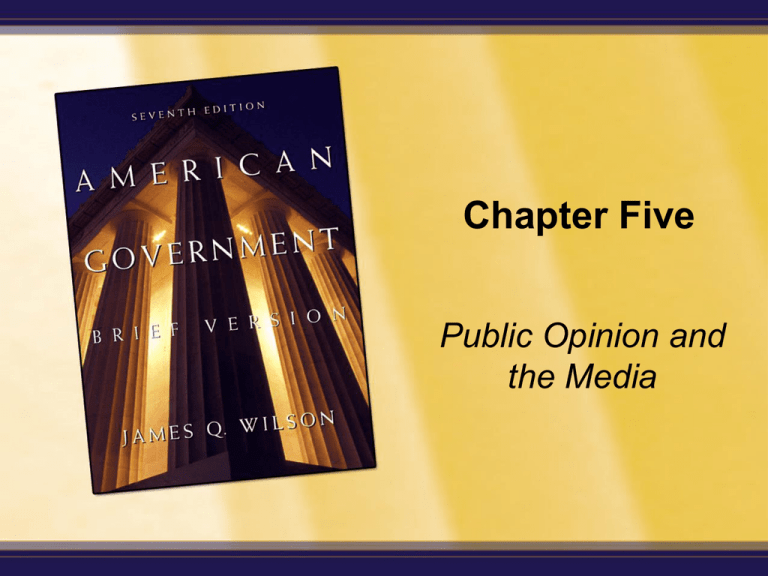
Chapter Five
Public Opinion and
the Media
Enduring Questions
• Under the United States Constitution, how big a
role should public opinion play in making policy?
• What are the biggest sources of the political
views of Americans?
• What is meant by “liberal” and “conservative”?
• Why is television news different from that in
newspapers?
• Are reporters biased in how they cover politics?
Copyright © Houghton Mifflin Company. All rights reserved.
5-2
Introduction: Public Opinion Polling
• Government policy often at odds with
public opinion
• Media and government officials often have
adversarial relationship
• What is public opinion?
Copyright © Houghton Mifflin Company. All rights reserved.
5-3
Why Do We Distrust the Federal Government?
• Steady decline since 1960s
• Vietnam, Watergate, Clinton impeachment
• Pre-WW II trust levels
• September 11, 2001
Copyright © Houghton Mifflin Company. All rights reserved.
5-4
Figure 5.1: Trust in Government Index
1958–2002
Source: The National Election Studies, September 16, 2003.
Copyright © Houghton Mifflin Company. All rights reserved.
5-5
Origins of Political Attitudes –
Political Socialization
• The role of the family
• Effects of religion
• Education, especially college and postgraduate education
• The “gender gap”
Copyright © Houghton Mifflin Company. All rights reserved.
5-6
Table 5.1: The Relationship Between Politics
and Religion (Among White Voters Only)
Copyright © Houghton Mifflin Company. All rights reserved.
5-7
Table 5.2: The Gender Gap: Differences in
Political Views of Men and Women
Copyright © Houghton Mifflin Company. All rights reserved.
5-8
Cleavages in Public Opinion
• Cleavages are complex and reflect the
heterogeneity of the U.S. society
• Occupation
• Race
• Region
Copyright © Houghton Mifflin Company. All rights reserved.
5-9
Table 5.3: White Versus Black Opinions
Copyright © Houghton Mifflin Company. All rights reserved.
5-10
Political Ideology
• Many people are neither liberals nor
conservatives
• Consistent attitudes
• Activists
• Various categories of opinion
• Analyzing consistency
Copyright © Houghton Mifflin Company. All rights reserved.
5-11
The Impact of the Media
• Members of the media have more
adversarial relationship with government
• Due to Vietnam and Watergate
• Economics force change; number of
media outlets and competition have
increased
• Media covers what public wants to see;
competing for viewers
Copyright © Houghton Mifflin Company. All rights reserved.
5-12
The Structure of the Media
• Degree of competition
• The national media
Copyright © Houghton Mifflin Company. All rights reserved.
5-13
Rules Governing the Media
• Freedom of the press
• Regulation and deregulation
Copyright © Houghton Mifflin Company. All rights reserved.
5-14
Government and the News
• Government officials seek to shape public
opinion
• Prominence of the president
• Coverage of Congress
Copyright © Houghton Mifflin Company. All rights reserved.
5-15
Interpreting Political News
• Public relies on, yet distrusts, TV news
coverage
• Are news stories slanted?
• News leaks
• The influence of media opinions on public
opinion and politics
• The influence of politicians on the media
Copyright © Houghton Mifflin Company. All rights reserved.
5-16
Figure 5.2: Young People Becoming Less
Interested in Political News
Source: Los Angeles Times, Times Mirror Center for the People and the Press (June 28, 1990).
Copyright © Houghton Mifflin Company. All rights reserved.
5-17
Reconsidering the Enduring Questions
• Under the United States Constitution, how big a
role should public opinion play in
making policy?
• What are the biggest sources of the political
views of Americans?
• What is meant by “liberal” and “conservative”?
• Why is television news different from that in
newspapers?
• Are reporters biased in how they cover politics?
Copyright © Houghton Mifflin Company. All rights reserved.
5-18

